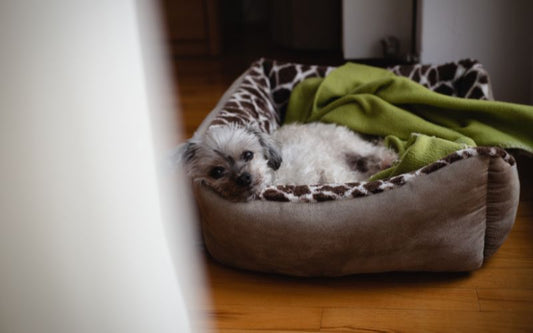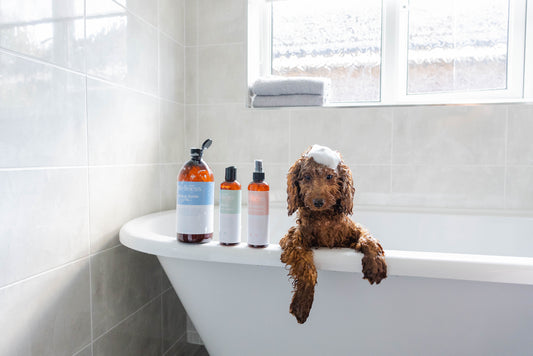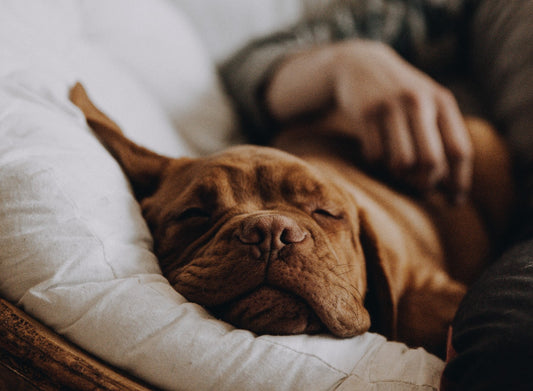If you’ve just collected your four-legged bundle of joy, you may already be thinking ‘when can I take my puppy for a walk?’. As excited as you’ll be to introduce your new puppy to friends and family, or set off on adventures with your little furry friend, enjoying long walks and unconditional love, it’s really important not to rush things.
Keeping your puppy happy, healthy and safe should always be your first priority. Although socialisation is key to building their confidence and getting them used to their environment, you’ll want to take the right steps so you’re not putting their health at risk, allowing their bones and joints to develop in full.
- When can my puppy go outside?
- Can I take my puppy for a walk after its first vaccination?
- Puppy vaccination information:
- How do you walk a puppy for the first time?
- How far should I take my puppy for a walk?
- What happens if I walk my puppy too much?
- How to exercise puppies without going on walks:

When can my puppy go outside?
In their first few weeks, puppies are incredibly vulnerable, so taking them outside too soon runs the risk of exposing them to nasty viruses. If you have a secure garden that is safe from unvaccinated dogs, you can spend time outside to start their toilet training, but make sure you keep a close eye on them.
Vets tend to recommend waiting two weeks after their second vaccination before heading out to public spaces. This allows plenty of time for them to settle into their new home, and for their natural immune system to kick in.
Can I take my puppy for a walk after its first vaccination?
It’s important to wait until your puppy is fully vaccinated before you start walking. If your vet agrees, they may say it’s okay to take your pup out with you if you carry them in your arms or in a carry bag, but you should never put them on the floor.
While you wait for their second vaccination, make the most of your safe space at home and introduce your puppy to its collar. Pop it on for short periods of time, then once they’re comfortable wearing it, start walking them on a lead in the garden so they know what it feels like before you hit the streets.
If you have friends with friendly, vaccinated dogs you could also arrange a playdate in your garden for their first dog-meet-dog experience.
Puppy vaccination information: 💉
- First puppy vaccination at 8-10 weeks of age
- Second vaccination is given 2-4 weeks after the first, at roughly 12 weeks old
- Annual boosts to follow each year to keep up their protection
- These vaccinations help to protect puppies from catching: Parvovirus, Infectious Canine Hepatitis, Distemper and Leptospirosis.
- An additional vaccine can be given to protect against kennel cough

Photo: Dachshund puppy holding Barc London's lilac city dog lead.
How do you walk a puppy for the first time?
It’s the moment you’ve been waiting for and a milestone in your puppy’s journey, but the big wide world can be a scary place so it’s really important to take it slow, understanding that you may not get very far on the first time!
Here are a few things to consider before you head out on your puppies first walk:
- Is your puppy comfortable wearing a collar? Make the most of time at home with your puppy and get them used to wearing one so they’re ready for their first walk.
- It’s best to pick somewhere calm and quiet, whether that’s the street you live on or a grassy area nearby.
- Keep it short and sweet while you build up their endurance and avoid overwhelming them with too much stimulation. After you’ve mastered a few short walks, their confidence should start to build.
- Avoid the hottest/coldest parts of the day. Puppies are more susceptible to temperature changes and it’s a lot easier for them to overheat. You should also check the floor temperature as this can damage your pup's foot pads if it’s too hot.
- Maintain a loose short dog lead whenever safe to do so. Tension on the lead can cause stress and prevent your pup from communicating effectively.
- Arm yourself with tasty treats and reward your pup when they show good behaviour. Whether that’s when they say a polite hello to another human or dog, choose to walk near you, or simply look to you for reassurance, by rewarding the behaviour you’ll hopefully see it more often, and in turn build their confidence being out and about.
- Dogs use their eyes, ears and nose to examine things, so don’t be surprised if there’s lots of stopping and sniffing on your first walk.
- Keep an eye on their body language, if they start to lie down or pant it could be a sign they’ve had enough for today. You don’t want to overstretch them physically or mentally.
- This may be the first time your puppy is meeting other pups and humans, which can be quite intimidating for them. Don't be surprised if they're a little nervous and always ask other dog owners if it’s ok for your pup to say hello, you never know how a dog will react.
Oh, and don’t forget your puppy's essentials: poo bags for the inevitable, and plenty of water to keep them hydrated. It’s also a legal requirement that you have an ID tag on your pups collar.

Photo: Golden Retriever puppy wearing Barc London's blue dog collar and lead set.
How far should I take my puppy for a walk?
A general rule of thumb is that a puppy can walk five minutes for every month of their age, starting from 8 weeks old. So, if your puppy is 2 months old, they can walk for roughly 10 minutes at a time.
You’ll also need to consider your puppy's breed, as over exercising larger dog breeds and giant breeds can lead to orthopaedic problems when they’re fully grown. This is due to the fact that they grow quicker than smaller breeds, but mature slower.
It’s always a good idea to check with your vet to confirm your puppy’s specific needs.
What happens if I walk my puppy too much?
Unfortunately, there is such a thing as too many walks for a pup, and by over exercising them you risk affecting their musculoskeletal development, particularly their growth plates (the area of cartilage at the ends of the leg bones).
Too much exercise can also cause exhaustion - puppies can get over tired very easily, and sometimes even injury as they are not yet fully developed. If at any point you think your puppy has overworked their muscles, pop to the vet for a check up to make sure he or she is ok.
How to exercise puppies without going on walks:
There are lots of other ways you can exercise your puppy, such as with a game of fetch with their favourite toy or letting them burn off energy in the house. Puzzle toys, or a kong stuffed with a tasty treat are also great at getting their brain working and providing much needed mental stimulation.
Give your puppy a few exercise sessions a day and make sure they get plenty of quiet time in between to sleep.
🐕
You have years of adventures and longer walks to come, so cherish the small moments and take time to build their confidence, we promise they’ll thank you for it in the future.


